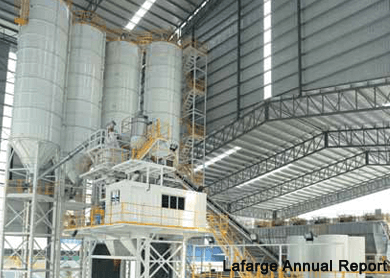
CEMENT consumption in Malaysia will not be robust in the near future, even though there are ongoing infrastructure projects. The key factor that has curbed the growth in demand is the slowdown in the property sector.
Lower energy costs expected this year will provide some breathing space for cement producers such as Lafarge Malaysia Bhd, Tasek Corp Bhd and Hume Industries Bhd. Demand, however, is forecast to increase between 3% and 4% this year — lower than last year’s 5% to 6% growth, according to analysts covering the cement sector.
“The property development sector makes up 50% to 60% of total cement demand in Malaysia,” says AllianceDBS Research analyst Woo Kim Toh, who covers Lafarge Malaysia.
“With the sector slowing down, infrastructure projects were expected to pick up the slack. However, demand from infrastructure projects such as the MRT Line 2 and LRT extensions have largely been priced in to the share prices of cement producers.”
Compounding the situation is the additional capacity expected to come on stream this year. YTL Cement Bhd, a wholly-owned subsidiary of YTL Corp Bhd (fundamental: 1.2; valuation: 1.4), will add 1.5 million tonnes or 8% capacity to the industry.
Market leader Lafarge Malaysia (fundamental: 1.8; valuation: 1.1) is currently expanding the capacity of its plants in Rawang, Selangor, and Kanthan, Perak, which will add 1.2 million tonnes to the industry.
Interestingly, Lafarge Malaysia and Tasek Corp (fundamental: 2.7; valuation: 1.7) are still trading at high price-earnings ratio of 33 times and 19 times respectively. Indeed, the valuations are higher than that of construction companies such as WCT Holdings Bhd and Gamuda Bhd, which are trading at 16 times earnings per share.
The illiquid nature of Lafarge Malaysia and Tasek Corp is partly to blame for the persistently high valuations. Lafarge SA of France holds a 51% stake in Lafarge Malaysia, followed by the Employees Provident Fund with 9%, while HL Cement (M) Sdn Bhd and Aberdeen Asset Management hold 74.3% and 20.24% equity interest respectively in Tasek Corp.
“Institutional investors and funds like to hold on to cement producers because of the decent yield. Despite the below-expectation results of Lafarge Malaysia last year, the company still paid good dividends,” says Woo.
Dividend yields of cement producers stand at 3% to 4%, based on last Thursday’s share price.
Despite the expected slowdown in demand, Lafarge Malaysia president and chief executive Bradley Mulroney is still sanguine about the prospects of the cement market.
“Market demand is reasonably strong. There are still a lot of infrastructure and housing developments taking place,” Mulroney tells The Edge.
However, large infrastructure projects only account for about 40% of the total cement market in Malaysia, he says, adding that the property development sector is the driving force behind local cement demand.
“Even if you get very strong growth in infrastructure, it only makes up 40% of the market anyway. It is very important but not to be exaggerated.”
The difficult market conditions for cement producers can be seen from the keen price competition. Cement producers compete by giving customers rebates.
According to AllianceDBS Research’s Woo, during good times when demand is strong, the rebate ranges from RM30 to RM40 per tonne. Due to the slowing demand from the property development sector and the impending excess capacity, cement producers have been reducing their prices even more.
“On average, cement producers have been giving rebates of up to RM100 per bag,” says Woo.
Lower energy costs a slight reprieve
Energy costs make up about 30% to 40% of the production cost.
The recent 5.8% average reduction in electricity tariffs until Oct 15 is a temporary reprieve for cement manufacturers, CIMB Research analyst Sharizan Rosely says in a report dated Feb 17. However, it is still insufficient to offset the average tariff increase of 16.9% last year, he adds.
Lower coal prices this year compared with last year will also benefit cement producers. Coal prices fell to US$56.60 per tonne on April 15, 26.2% lower than a year ago. Coal is largely used to fire rotary kilns during the blending of the raw materials to produce cement.
Nevertheless, the weak ringgit has erased this advantage — coal is mostly imported and are priced in US dollars, says a senior industry executive.
The industry’s practice of buying coal up to 24 months in advance could also have worsened the situation, as companies may have locked in a higher price for the fuel, the executive adds.
Analysts covering Lafarge Malaysia have mixed views on the stock.
HLIB Research has a “buy” call on the stock with a target price of RM10.72, while AMMB Research and Maybank IB Research are calling a “hold” with target prices of RM8.90 and RM9.30 respectively. Kenanga Research and AllianceDBS Research have “sell” calls with target prices of RM8.20 and RM8.30 per share respectively.
Meanwhile, CIMB Research is the sole research house covering Tasek Corp — it has a “hold” call with a target price of RM16.46. No research house covers Hume.
As at last Thursday, Lafarge Malaysia’s share price had increased 3.7% year to date to RM10.04 per share, giving the group a market capitalisation of RM8.53 billion. Tasek Corp’s share price increased 3.32% YTD to RM16.18 (market capitalisation of RM1.96 billion), while Hume bucked the trend, falling 10% to RM3.60 per share (market capitalisation of RM1.72 billion).
Note: The Edge Research’s fundamental score reflects a company’s profitability and balance sheet strength, calculated based on historical numbers. The valuation score determines if a stock is attractively valued or not, also based on historical numbers. A score of 3 suggests strong fundamentals and attractive valuations. Visit www.theedgemarkets.com for more details on a company’s financial dashboard.
This article first appeared in The Edge Malaysia Weekly, on April 20 - 26, 2015.
Save by subscribing to us for your print and/or digital copy.
P/S: The Edge is also available on Apple's AppStore and Androids' Google Play.